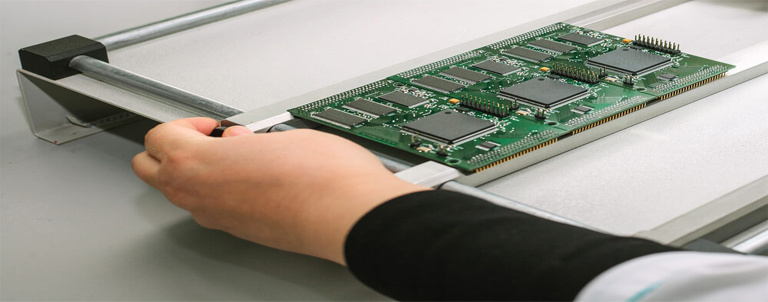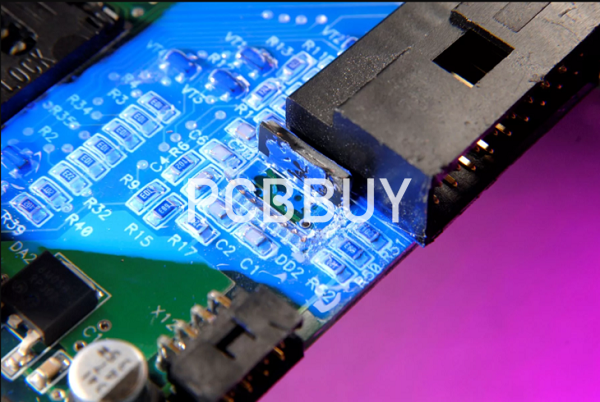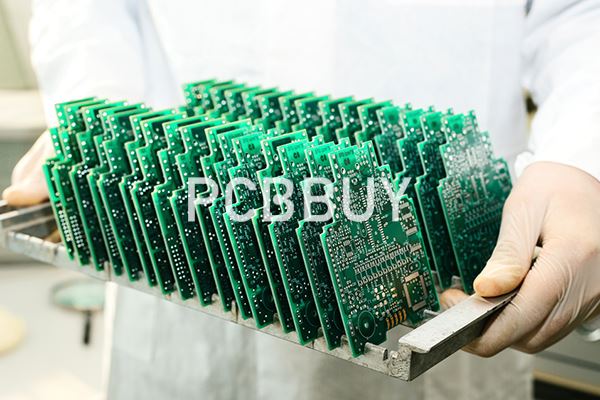PCB conformal coating
By:PCBBUY 07/17/2021 17:09

To prevent PCB’s exposure to environmental hazards such as extreme temperature, humidity, corrosion and dust, conformal coating. Is one of the protective measures to avoid it being exposed to a range of unique environments. Any of these environmental conditions harm the components’ integrity and functionality.
In this passage we will provide all the professional knowledge of conformal coating. And if you are searching for the information about it, please check and read the content we prepare below.
If you want to order PCB product, please check and custom your order online.

What is the definition of conformal coating?
What is conformal coating and what is it used for? In short, conformal coating is a thin, transparent film that can be applied to the surface of a circuit board. This film contours to the PCB’s shape, protecting components from environmental conditions without impacting functionality.
But is conformal coating necessary? While not all applications are best served by conformal coating, it can be an excellent choice for specific types of PCBs. Some of the benefits conformal coating offers include the following:
· Protection: Conformal coatings protect assemblies from environmental hazards such as chemicals, corrosion and dust.
· Lightweight: PCB conformal coatings do not significantly increase the board’s weight.
· Insulation: Conformal coating provides insulating properties, allowing a reduction in PCB conductor spacing.
These benefits are all provided without needing sophisticated or highly designed protective elements.
What is the working principle of conformal coating on PCB?
Conformal coatings may be applied to circuit boards using various methods, which differ in quality level, reliability and production level. The most notable application methods include the following:
· Brush method: In this technique, conformal coating materials are applied by hand using a brush. These coatings tend to be thick and less consistent than those applied by other methods. This process is simple and labor-intensive and best suited for low-volume production and rework and repair operations.
· Spray method: The spray method involves using an aerosol spray to apply conformal coating materials to PCB surfaces. Ideal for low-volume production, this technique provides an excellent surface finish consistency but is also time-consuming as it requires a thorough application to cover the entire board.
· Dipping method: The dipping method involves applying conformal coating to circuit boards by submerging them in the coating solution. Fast, accurate and thorough, this method is ideal for high-volume production. However, it is only useable on certain types of PCBs with designs that prevent leakage and can be coated on both sides of the board.
· Selective coating: The selective coating method uses robotic spray nozzles to apply coating materials to specified areas of a PCB assembly. This automated process is ideal for high-volume applications, offering a fast and accurate procedure that can be used on a wide range of boards. Like the dipping method, the board must be designed to be compatible with selective coating.

With each of these application methods, the conformal coating must be very thin to minimize heat entrapment and weight increase, among other concerns. Typically, conformal coatings are between 3 to 8 mil thick. How do you measure conformal coating? This is usually done with a micrometer, current probe or specialized gauge that uses physical measurements, electromagnetic fields or ultrasonic waves to take measurements of the coating after it is dry.
What are the types of conformal coating?
Many types of conformal coating materials exist, including a range of specialty varieties. The most common of these conformal coatings are described below, along with their most prevalent applications:
· Urethane resin: Urethane resins (UR) or polyurethane resins are known for their excellent resistance to moisture, abrasion and chemical attacks. The downside of this material is that it is resistant to solvents, meaning it is difficult to remove and rework. Urethane resins are most commonly used in aerospace applications where components may be exposed to corrosive fuel vapors.
· Acrylic resin: Acrylic resins (AR) are acrylic polymers dissolved in a solvent. These substances require a simple drying process and are easy to rework. When complete, this type of coating provides good general protection against humidity and other environmental factors but poor protection from solvents and chemical vapors, making it most suitable for basic-level protection. The major upside of this material is the ease with which it can be removed and reworked, making it practical for repair operations.
· Epoxy resin: Epoxy resin (ER) coatings are compounds that create a hard layer with good humidity, abrasion and chemical resistance, with minimal permeability. Less flexible than other types of coatings, epoxy resins are difficult to remove and rework. Epoxy is the most common choice for PCBs that need to be coated completely and is often chosen for applications with low mechanical stress.
· Silicone resin: Silicone resin (SR) coatings provide excellent thermal, chemical, moisture and corrosion resistance while maintaining good flexibility. This type of coating is difficult to remove and offers poor abrasion resistance due to the surface’s rubbery texture. However, it makes up for this in offering good resilience against vibrational stress. Silicone resin conformal coatings are often chosen for electronics in outdoor environments that are exposed to broad temperature and moisture conditions.
· Parylene: Parylene (XY) coatings are applied through chemical vapor deposition. In this process, the parylene is heated to become a gas and put into a vacuum chamber to polymerize and turn into a thin film, which is placed over electronics. This film offers excellent dielectric strength and resistance to extreme temperatures, moisture and corrosive elements. However, it is also difficult to remove and rework, requiring abrasion techniques to remove. The specialized production process also makes replacing parylene coating more difficult than other methods. It’s often used in specialty applications.
When considering what types of conformal coating are best suited for your application, consider the application’s requirements, including the required functionality and environmental conditions in which the PCB will operate.
Industry Category











